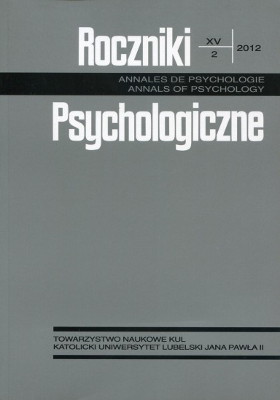How is promotion-focused and prevention-focused self-regulation linked with the importance of product attributes and purchase intention?
Abstract
Two experiments were carried out to examine consumer preferences in the context of Higgins’ Regulatory Focus Theory. Study 1 (N = 134) tested whether chronic regulatory focus (RFQ) and momentary regulatory focus affect the importance attached to functional and hedonic product attributes. Study 2 (N = 240) checked whether the regulatory fit of consistent or inconsistent advertisements (types of advertisement appeal: prevention and promotion, and types of products: functional and hedonic) and chronic regulatory focus (RFQ) are linked with intention to purchase an advertised product. The results obtained in study 1 indicated that prevention momentary regulatory focus or promotion chronic regulatory focus influence the importance attached to utilitarian product attributes, whereas no such influence was observed for the importance attached to hedonic product attributes. The results obtained in study 2 showed that consistent promotion advertising and promotion chronic regulatory focus affect the intention to buy a product. Moreover, the findings demonstrated that inconsistent advertisements (i.e. hedonic product and prevention advertising appeal) and promotion chronic regulatory focus affect the intention to purchase a product. It was also found that there is no significant influence of consistent prevention advertising and prevention chronic regulatory focus on the intention to buy a product.
References
Aaker, J. L., Lee, A. Y. (2001). I seek pleasure and we avoid pains: The role of self-regulatory goals in information processing and persuasion. Journal of Consumer Research, 28, 33-49.
Avnet, T., Higgins, E. T. (2006). How regulatory fit affects value in consumer choices and opi- nions. Journal of Marketing Research, 43, 1-10.
Brzezińska, A. (2000). Społeczna psychologia rozwoju. Warszawa: Wydawnictwo Naukowe Scholar.
Brzeziński, J. (1996). Metodologia badań psychologicznych. Warszawa: Wydawnictwo Naukowe PWN.
Cesario, J., Grant, H., Higgins, E. T. (2004). Regulatory fit and persuasion: Transfer from “feeling right”. Journal of Personality and Social Psychology, 86, 388-404.
Cesario, J., Higgins, E. T. (2001). Value from fit, subjective experience, and persuasion: “When it feels right, it is good” (mps, Columbia University).
Chernev, A. (2004). Goal-attribute compatibility in consumer choice. Journal of Consumer Psychology, 14, 141-150.
Doliński, D., Drogosz, M. (2007). Czy obywatele poszliby głosować przeciw? Regulacyjne nastawienie na promocję vs. prewencję a aktywność społeczną. W: Z. Ratajczak (red.), Psychologia wobec dylematów współczesności (s. 103-116). Kolokwia Psychologiczne, 16.
Foerster, J., Werth, L. (2007). How regulatory focus influences consumer behavior. European Journal of Social Psychology, 37, 33-51.
Forster, J. (2003). The influence of approach and avoidane motor actions on food intake. European Journal of Social Psychology, 33, 339-350.
Higgins, E. T. (1987). Self-discrepancy: A theory relating self and affect. Psychological Review, 94, 319-340.
Higgins, E. T. (1997). Beyond pleasure and pain. American Psychologist, 52, 12, 1280-1300.
Higgins, E. T. (1998). Promotion and prevention: Regulatory focus as a motivational principle. W: M. P. Zanna (red.), Advances in experimental social psychology (vol. 30, s. 1-46). New York: Academic Press.
Higgins, E. T. (2000). Making a good decision: Value from fit. American Psychologist, 55, 1217-1230.
Higgins, E. T. (2005). Value from regulatory fit. Current Directions in Psychological Science, 14, 209-213.
Higgins, E. T., Friedman, R. S., Harlow, R. E., Idson, L. C., Ayduk, O. N., Taylor, A. (2001). Achievement orientations from subjective histories of success: Promotion pride versus prevention pride. European Journal of Social Psychology, 31, 3-23.
Higgins, E. T., Roney, C. J., Crowe, E., Hymes, C. (1994). Ideal versus ought predilections for approach and avoidance: Distinct self-regulatory systems. Journal of Personality and Social Psychology, 72, 515-525.
Idson, L. C., Higgins, E. T. (2000). How current feedback and chronic effectiveness influence motivation: Everything to gain versus everything to lose. European Journal of Social Psychology, 30, 583-592.
Liberman, N., Molden, C. D., Idson, C. L., Higgins, E. T. (2001). Promotion and prevention focus on alternative hypotheses: Implications for atributional functions. Journal of Personality and Social Psychology, 80, 1, 5-18.
Safer, D. (1998). Preferences for luxurious or reliable products: Promotion and prevention focus as moderators (mps pracy doktorskiej, Columbia University, Department of Psychology).
Spotts, H. E., Weinberger, M. G., Parsons, A. L. (1997). Assessing the use and impact of humour on advertising effectiveness: A contingency approach. Journal of Advertising, 26, 17-32.
Zawadzka, A. M., Niesiobędzka, M. (2010). Preferencje konsumenckie w kryzysie i rozwoju gospodarczym z perspektywy samoregulacji. Czasopismo Psychologiczne, 16, 2, 253-264.
Zawadzka, A. M. (1998). Osobowościowe uwarunkowania lojalności wobec marki produktu – analiza w aspekcie wybranych cech osobowości. Studia Psychologiczne, 36, 2, 75-94.
Zawadzka, A. M. (2006). Dlaczego przywiązujemy się do marki? Gdańsk: Gdańskie Wydawnictwo Psychologiczne.
Zawadzka, A. M. (2009). Twórcze sposoby przekonywania – reklamy oparte o symulacje mentalne. W: S. Popek, R. E. Bernacka, C. W. Domański, D. Turska, B. Gawda, A. M. Zawadzka (red.), Psychologia twórczości. Nowe horyzonty (s. 495-505). Lublin: Wydawnictwo UMCS.
Zawadzka, A. M., Popielarska, B. (1998). Osobowość programu telewizyjnego w oczach jego odbiorców i twórców – jakościowe spojrzenie na problem preferencji widza. Studia Psychologiczne, 36, 1, 93-118.
Copyright (c) 2012 Roczniki Psychologiczne

This work is licensed under a Creative Commons Attribution-NonCommercial-NoDerivatives 4.0 International License.


